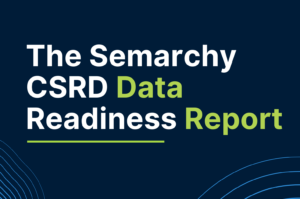With the introduction of new reporting rules, such as the Corporate Sustainability Reporting Directive (CSRD) and European Sustainability Reporting Standards (ESRS), companies are under pressure to handle their Environmental, Social, and Governance (ESG) data efficiently. Yet, many businesses are still struggling to keep up with these growing expectations.
At their core, these rules require detailed, precise, and verifiable ESG data — far beyond basic checklists for compliance. For example, the CSRD not only requires machine-readable ESG reports but also involves audits to track data back to its source. With the first mandatory reports due this year for certain companies, the time to act is now.
Although the need for ESG reporting is widely recognized, companies remain unprepared. According to Semarchy’s CSRD Data Readiness Report, only 17% of businesses are fully ready for CSRD audits. Additionally, 30% of surveyed companies admitted they could not describe their ESG data as “high quality and reliable.” This lack of preparedness highlights issues like disconnected systems, incomplete data records, and inconsistencies in reporting.

DOWNLOAD THE FREE REPORT NOW
However, these challenges can be overcome. Sixty-one percent of companies also see ESG reporting as an opportunity and a way to encourage innovation, showing there’s clear value beyond simply meeting the rules. Managing ESG data well can improve operational efficiency, boost a company’s reputation, and reduce long-term risks.
This blog will explore what ESG data management entails, why it matters, and share practical advice to help companies address challenges, meet reporting rules, and turn sustainability into a strength.
What is ESG data?
ESG data shows how a company performs across three key areas:
- Environmental data: Includes greenhouse gas (GHG) emissions, energy use, waste handling, and water consumption. These measures help companies track their environmental impact and work toward global climate goals like net-zero emissions.
- Social data: Focuses on areas like workplace safety, diversity, inclusion, fair wages, and community involvement. This reflects how a company’s actions affect employees and society.
- Governance data: Covers ethics, responsibility, data protection, leadership practices, and board diversity. Transparency in how a business is run builds trust and reduces the chances of reputation problems.
Together, these types of ESG data give a full view of a company’s sustainability efforts and provide an important foundation for both meeting rules and guiding decisions.
The role of sustainability data management and the EU taxonomy
The EU taxonomy categorizes environmentally friendly activities based on factors like climate protection, recycling efforts, and preserving biodiversity. Under CSRD, companies must align their activities with this system to report on their environmental performance.
This is where effective sustainability data management becomes crucial. Sustainability data often includes not only internal operations but also supply chains, logistics, and resources from partners. For example:
- Companies must report Scope 1 (direct), Scope 2 (energy), and Scope 3 (emissions from their supply chain).
- Accurate reporting of Scope 3 emissions depends on secure, traceable data sharing with suppliers — an area many businesses find challenging.
Meeting requirements involves strong systems that combine ESG data with sustainability data processes. These systems bring together various measurements into unified, ready-to-go formats that align with both legal and operational aims.
Why is ESG data management important?
Managing ESG data well not only ensures compliance with reporting rules but also supports goals like cutting waste and reducing risks. Let’s look at some of the main reasons why ESG data management is so important.
1. Meeting requirements with reliable data
The CSRD and other global standards increasingly demand accurate and traceable ESG reports. However, few companies are prepared: Semarchy’s survey reveals that just 17% of companies are fully ready for audits, and only 29% can create machine-readable ESG reports. Other big obstacles include siloed systems, incomplete data, and the difficulty of collecting information from supply chains (Scope 3 emissions).
Good ESG data management can help. Using systems like Master Data Management (MDM), companies can bring ESG information into one centralized location, automate checks for accuracy, and generate reports that fulfill audit needs. These systems track data back to its origin, ensuring clarity and consistency, even across complex supply chains.
2. Better handling of supply chain data
Reporting on supply chains, including Scope 3 emissions, is one of the hardest parts of ESG compliance — but it’s also one of the most impactful. According to Semarchy’s research, 25% of businesses said reporting on supply chains was their top challenge. Scope 3 emissions require gathering accurate, detailed data from suppliers, some of whom may work in regions with different rules or limited digital systems.
To tackle these challenges, effective supply chain data management uses MDM systems to combine and organize third-party data. Companies can simplify supply chain reporting by:
- Setting up secure, clear data-sharing systems with suppliers,
- Automating data checks to improve accuracy and reduce errors,
- Tracking where the data comes from to meet audit needs and improve clarity.
By adopting these steps, companies gain better insights into ethical sourcing, emissions trouble spots, and chances to build more sustainable supply chains.
3. Identifying new opportunities
Beyond following the rules, strong ESG data management can encourage new ideas, improve efficiency, and help the business grow.
For example:
- New ideas: Analyzing sustainability data uncovers ways to make products more efficient, create environmentally friendly supplies, and lower resource costs.
- Reputation improvement: Trustworthy ESG reports boost the company’s image with investors and environmentally focused customers.
- Stronger connections: Clear, accurate data builds trust with suppliers and partners, fostering long-term cooperation.
Aligning sustainability reporting with business goals allows companies to achieve both practical benefits and compliance.
4. Reducing risks with ESG insights
Good sustainability data management helps companies get ahead of risks, whether from breaking rules or damaging their reputation. Accurate data supports better business planning, helping leaders reduce risks like high carbon emissions, weak supply chain practices, or workplace inequality.
Strong ESG reporting also reassures investors, who see it as a sign of stability. Poor reporting can lead to accusations of greenwashing, causing reputational harm that discourages partnerships and investment. In contrast, reliable ESG data promotes trust and gives all stakeholders confidence.
How to start improving ESG data management
Here are five key areas to focus on to enhance your ESG data management.
1. Establish clear ownership of ESG data
Managing ESG data well starts with assigning responsibility. According to Semarchy, most companies place this duty with Chief Data Officers (58%), but these leaders need support from IT, legal, and sustainability teams.
Key tips include:
- Assigning ESG data coordinators for accountability and consistency;
- Centralizing oversight to simplify reporting and avoid repeat efforts, and;
Building teamwork across departments to align all areas of the business with sustainability goals.
2. Centralize systems for connected ESG data
Scattered ESG data is one of the biggest obstacles to compliance. Only 27% of surveyed companies have brought their ESG data together into unified systems.
MDM solutions solve this by providing:
- A single location for all ESG data;
- Tools to organize data across departments, supply chains, and reporting structures, and;
- Flexible systems that can adjust to changing rules like the CSRD.
Centralized systems make reporting easier, break down silos, and improve data quality.
3. Improve data quality with automation
Reliable ESG data depends on good quality. Automating checks for accuracy improves data reliability and ensures compliance with benchmarks like the EU taxonomy.
Tools like Semarchy include validation in their workflows, enabling companies to:
- Spot and fix errors immediately,
- Improve clarity across complex data,
- Meet audit needs with minimal manual work.
Using automation reduces mistakes and speeds up the process of creating sustainable business reports.
4. Create ESG-specific reporting systems
Scope 3 emissions and financial sustainability measures, in particular, need detailed, flexible models.
Using Semarchy, teams can:
- Create ESG frameworks customized for changing global rules,
- Link sustainability data across business, financial, and supply chain areas,
- Produce accurate, consistent reports that meet audit needs.
5. Strengthen security and trust in your data
Protecting your data is essential for both trust and compliance. Using Semarchy’s data governance tools, businesses can implement measures like encryption, access controls, and data history tracking to:
- Keep sensitive ESG data safe while meeting GDPR and CSRD rules,
- Build systems that reduce errors and ensure full transparency.
Turning ESG compliance into opportunity
Managing ESG and sustainability data isn’t just about following the rules — it’s about creating value for the business. With unified systems, automated processes, and customized data tools, companies can confidently meet today’s reporting needs while preparing for tomorrow’s challenges.
The clock is ticking. CSRD-compliant reports are due soon — companies should act now to build strong systems that meet current demands while setting the stage for future sustainability success.
DOWNLOAD THE FREE REPORT NOW
Share this post
Featured Resources

CSRD Readiness Research



















































